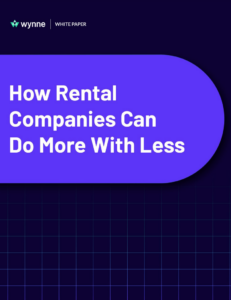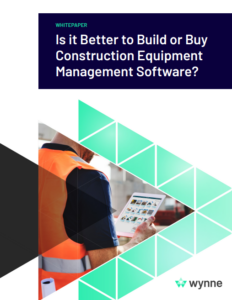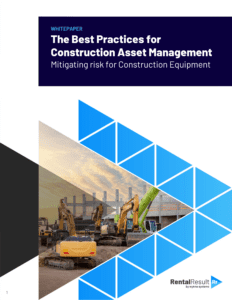Whitepaper
Integrations Unlocked
Build an enterprise of connectivity with construction equipment management software
- About RentalResult Integrations
- Equipment Management Platforms: Why They Matter
- What Equipment Management Platforms Can Do
- Sourcing Construction Equipment Management Software
(No, we don’t need your email)
The construction industry is going through a particularly volatile period. While the overall value of the market is rising, this is in part due to inflation rather than increasing opportunities. According to Deloitte Insights, the primary challenges facing construction companies include soaring material prices and labor costs, plus the lack of skilled laborers across the industry.[i]
A top trend they highlighted was the rise in digitalization. In fact, they predicted that throughout 2024 and beyond, construction firms can unlock new sources of value by prioritizing investment in the right technological solutions.
As costs rise, finding ways to maximize efficiency and optimize budgets becomes necessary rather than just desirable. This means utilizing tools that can integrate with existing Enterprise Resource Planning software (ERP) systems to avoid the wasted time and effort of duplicating data entry.
A prime example of required integrations is construction equipment management software solutions. These tools handle multiple aspects of automation, analysis, and asset management. The more features a digital platform provides, the more potential cost savings construction firms enjoy. However, without the ability to integrate seamlessly with existing systems, construction management software could represent a poor investment.
In this whitepaper, you will learn how to address equipment management platform integration challenges and the benefits working with the right partner provides. For questions, comments, or clarifications, please contact the authors, Wynne Systems, at 949.224.6300 or schedule a call online.
Equipment Management Platforms: Why They Matter
Construction firms must have effective ways to track their assets, including equipment and tools. While construction equipment theft is a significant concern, costing the industry an estimated $1 billion annually according to the National Equipment Register (NER)[ii], it’s just the tip of the iceberg. Understanding where assets are always is essential to effective construction business practices.
However, many enterprises are still using outdated systems to monitor the whereabouts of their assets and how each piece of equipment contributes to your company’s profitability. These methods may include Excel spreadsheets, bespoke databases, or even digital or physical whiteboards. Disorganized equipment management leads to a multitude of hidden costs that can significantly impact your bottom line.
- Crippling Utilization Rates: Traditional methods make it difficult to track equipment usage across projects. This lack of visibility leads to underutilization, where expensive equipment sits idle, generating no revenue while accruing depreciation costs.
- Lost Productivity: Misplaced or lost tools and equipment are a constant battle for construction crews. Time spent searching for missing items translates to reduced productivity and delays in project completion.
- Maintenance Mayhem: Without a centralized system for tracking maintenance schedules, crucial preventive maintenance tasks can be easily missed. This leads to unexpected equipment breakdowns, increased repair costs, and project downtime.
- Bidding Blind Spots: Inaccurate equipment data hinders accurate project cost estimates. Blind spots regarding equipment availability and true utilization rates can lead to under-bidding projects, squeezing profit margins.
Sometimes the reason for utilizing the same methods that have been used for perhaps over a decade is because construction firm leaders aren’t aware of the alternative. A digital construction equipment management platform provides companies with a simple way to track every asset. In an industry where everything is complex from planning to completion, there’s very little room for error. Equipment management tools reduce the potential for mistakes by eliminating the need for manual tracking and data entry.
What equipment management platforms can do:
Asset Tracking and Management
Construction equipment management tools remove the requirement for separate databases and spreadsheets that are prone to errors. Effective system integration means that as soon as equipment is allocated to a project, the construction management solution logs it and can provide instant reports on where assets are and what’s available.
Customer Contact Management
As a business expands, it becomes unsustainable to maintain multiple databases of customer or client details. Switching between systems and relying on manual data entry creates a high risk of human error. This, in turn, leads to client dissatisfaction, a drop in company reputation, and even financial detriment.
Financial Management
Another way some equipment management solutions optimize performance is by centralizing financial management. The ability to create invoices automatically, view goods orders, and run financial reports within moments means these tools can effectively replace outdated legacy accounting systems. Integration with existing ERPs and inventory management systems makes construction equipment management tools essential for maximizing budgets.
Workflow Management
Understanding the journey of construction equipment, clients, and related monies from start to finish helps everyone in the business work more productively and collaboratively. Shorten workflows, ensure all stakeholders are kept informed, and make interactions with construction technology simpler — those are some of the primary benefits of investing in construction equipment management software.
Sourcing Construction Equipment Management Software: The Ideal
Utilizing construction management software should be intuitive and offer a shallow learning curve. Administrators or project leaders might create a project within their existing ERP, for example, Oracle or SAP. This action prompts an identical project to be created within the corresponding construction equipment management software. The two systems are now connected and use sub-tasks and web-based messaging protocols to provide instant updates on equipment requirements.
The new software carefully logs all the equipment used and, where appropriate, generates invoices automatically once the project leader/superintendent ends the task or project at the source ERP side.
Construction management solutions should integrate with all relevant systems for pricing and client data to ensure invoices are accurate and sent to the right personnel. These advanced applications can also manage supplier accounts, orders, and goods receipts via a similar interplay between related systems.
The Reality
Unfortunately, in many cases, construction equipment management tools don’t come with the right integrations out of the box. Construction firms may invest in a product only to discover that it can’t connect to their existing ERP, for example:
It’s unreasonable for software vendors to expect long-established construction firms to veer away from systems that are integrated throughout their entire organization. A large enterprise isn’t going to stop using Oracle, for example, just to connect to a new tool. However, construction companies want the potential cost benefits that come from investing in construction equipment management software.
Many enterprises will simply go without the equipment management tools that they need to improve their efficiencies and cost management because they cannot find vendors that support the integrations they need. This becomes an even tougher challenge with older, legacy systems.
The Solution
To minimize costs and maximize security, disparate, widely distributed systems that do not integrate are a poor choice. Ideally, construction management software should connect seamlessly with existing ERP systems to be a viable option for buyers.
Advanced construction management solutions provide ways to connect to multiple applications via SOAP (simple object access protocol or REST (representational state transfer). By leveraging widely used communication standards, construction management becomes practical and beneficial regardless of the systems and applications currently used by firms.
Forward-thinking software providers like Wynne Systems opted to utilize these technologies, effectively creating open systems that are virtually integration-agnostic.
RentalResult Construction Equipment Management Software
Wynne Systems’ proprietary construction equipment management software, RentalResult, provides numerous ways to control business costs, enhance visibility across the equipment supply chain, and increase productivity via more efficient workflows.
The system provides a customer portal and connections to suppliers to integrate every aspect of equipment management. The Reporter feature allows the analysis and visualization of highly complex data. There are even mobile applications to increase the accessibility of information.
Better equipment management allows firms to scale their businesses faster. RentalResult is trusted by so many construction enterprises because it allows them to continue using their current systems. Rather than having a strictly limited number of integrations, RentalResult can be adjusted to connect to any ERP a business many already have in place.
Wynne Systems works with multiple large construction firms who didn’t want to move away from their reliable and trusted ERP systems, but still wanted the significant cost savings possible with RentalResult . The equipment management platform can integrate with all ERPs and even legacy systems thanks to the SOAP and REST technologies.
SOAP
SOAP is a common messaging protocol that’s employed to allow distributed components of a system to communicate effectively. Many ERPs have SOAP connectors, which allow tools with SOAP capabilities to connect to them. For example, Oracle uses a SOAP adapter specifically designed to help IT teams build bespoke integrations. A construction firm can work with a partner like Wynne Systems to ensure these integrations are effective and connect to tools with features that matter to that company.
REST
REST represents a standardized architectural standard for communication across the internet. REST APIs (application programming interfaces), sometimes called RESTful APIs, provide ways to connect one system to another without a pre-existing integration. If a construction ERP has REST capabilities — as most do — RentalResult is able to connect to it.
Sometimes, older legacy systems don’t have SOAP or REST capabilities. Wynne Systems worked with one well-established construction firm that wanted the benefits of RentalResult but didn’t have an ERP with the right communication capabilities. However, the team at Wynne Systems used existing middleware to create bespoke integrations that provided all relevant benefits to the company.
Having a deep understanding of the technology currently utilized by the construction industry gives Wynne Systems the advantage when it comes to creating software solutions that provide genuine value.
How Construction ERP Vendors Assuage Security Concerns
Some objections to committing to integrated solutions revolve around cybersecurity and associated concerns. While construction firms might not seem like the obvious target for threat actors (cybercriminals), attacks are on the rise. Large volumes of both data and money travel through construction companies and their clients, so exploiting vulnerabilities can be lucrative for opportunistic threat actors.
One primary concern is the expanding surface of digital interactions. By utilizing more digital tools, firms become available at more points across networks and the cloud. However, secure integrations to a trusted equipment management platform mitigate some of this concern by housing multiple features within a single secure platform. Instead of separate portals for finance, POS, contact management, asset tracking, and other features, the right platform provides all those tools in one place.
Construction equipment management software could reduce a company’s network surface, helping firms create a more robust cybersecurity posture.
Related Reading: Protecting your rental company from costly cyber-attacks
Xylem Case Study
Sometimes the integrations firms require are completely unique. Choosing an enterprise-level partner that can circumvent these challenges with ease is essential.
In 2022, Xylem worked with construction ERP provider Wynne Systems to integrate unique, organization-specific systems with a brand-new interface.
About Xylem: Xylem is a water technology and water solutions provider for various industries including public utilities, agriculture, construction, and many more.
Primary challenge: Xylem’s proprietary system, FST, allows clients to log in and engage in remote water pump monitoring. Pumps have GSM devices attached so if there’s a fault, clients can get notifications in real time. Integrating this data into a larger ERP was difficult due to the type of communication used and the stand-alone systems.
Solution: Utilizing industry knowledge and systems coding expertise, Wynne Systems managed to create integrations with:
- Pump manufacturing systems — an integration that includes notifications when the tracking devices are added.
- Pump servicing systems — this also updates systems if the tracking devices are changed.
- Pump sales.
- Active and inactive monitoring — this allows Xylem to bill accurately for this service based on when the customer switches the monitoring on and off.
- Financial records — the new interface integrates every aspect of accounting from purchase orders to credit limits.
The ability to gain this level of integration from a single provider increases the ROI of investing in a new interface. Cost benefits are also gained from the benefits this provides to Xylem’s customers via more accurate updates and invoicing.
Outlook for Construction Management Software
To stay relevant in a volatile industry, construction leaders must opt for solutions that can handle multiple facets of the business and provide significant boosts to productivity, efficiencies, or cost management. The construction management software market has a compound annual growth rate (CAGR) of 10.2% currently, higher than growth across the entire construction industry over the last two years. By 2031, the construction software market may be worth as much as $23.9 billion.[iii] It’s clear that many firms are seeing the benefits of ERPs and similar solutions and making efforts to engage in digital transformation.
Gaining optimal benefits from construction management software requires engaging all stakeholders, from financers to end-users. From creating a good business case to ensuring team members know why and how to use new systems, proper preparation and implementation are vital.
With the right partnerships, construction companies and equipment rental firms can effectively future-proof their businesses by investing in scalable, advanced digital solutions today. This includes working with experts who know how to integrate those solutions with existing ERPs and even older legacy systems. There’s always a solution when you work with the right partner.
If you want to learn more about the benefits of investing in construction management software and how to source solutions that integrate with your current systems, please contact Wynne Systems at 949.224.6300 or schedule a call online.
[i] 2024 engineering and construction industry outlook | Deloitte Insights
[ii] National Equipment Register (NER)
[iii] Construction Management Software Market Size | 2031 (alliedmarketresearch.com)





